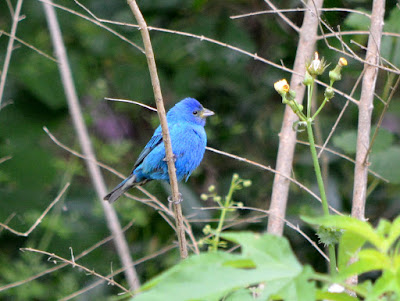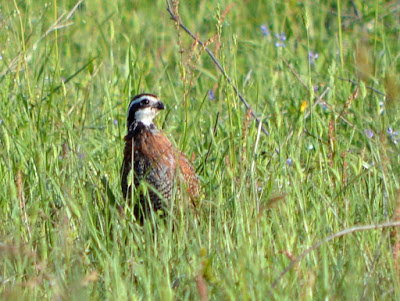.
We arrived at Boy Scout Woods only to be told by several people who were leaving that there were no birds around. Luckily, this turned out not to be true and I had my first bird - a Wood Thrush - within two minutes of entering the site.
We spent an hours walking the trails and compiled a nice if fairly small list of birds. Prothonotary Pond had a couple of Prothonotary Warblers and a Black-and-White Warbler as well as two more Wood Thrushes. The main drip had Hooded Warbler, Red-eyed Vireo, Swainson's Thrush, Summer Tanager, Rose-breasted Grosbeak and several Gray Catbirds. The latter were the most numerous species overall and we soon lost count of how many individuals we came across.
The best bird was a Kentucky Warbler which strolled about on the trail right in front of us.
We crossed the road to check out the garden of the guides' house and immediately added an Inca Dove to our list.
The trees there had a score of Cedar Waxwings while a bottlebush plant was hosting a Nashville Warbler.
An open patch nearby had not one, not two but seven Indigo Buntings.
By the time we had finished watching the Buntings, it was noon and so we set off on the guided trip to Bolivar.
We got to Rollover Pass before the rest of the group and parked as close to the far end of the beach as possible. Although there were plenty of birds in the air - including many Brown Pelicans - the water seemed to be largely empty except for a group of maybe 150 American Avocets in the far distance.
Then a couple of Laughing Gulls landed near us.
They were followed by a Ring-billed Gull.
I pulled the car forward a little and we realized there were a lot birds gathered on a parch of beach that hadn't been visible. We quickly IDed five Tern species: Royal, Forster's, Sandwich, Black and Least.
We were delighted to see that the group also included several dozen Black Skimmers.
Unfortunately, as we and our fellow birders were scanning the beach for other birds, we spotted this Royal Tern with a broken wing.
The water now had a couple of Snowy Egrets (below) and a Great Blue Heron.
A Tricolored Heron was fishing further away, along with some Black-necked Stilts.
A Black-belllied Plover posed by the water's edge while a Semipalmated Plover explored the sand.
Three Ruddy Turnstones were living up to their name and turning over most stones that they came across.
A group of Short-billed Dowitchers marched past.
A single Sanderling pottered about nearby.
Two Western Sandpipers also appeared.
Willets patrolled the shallow water in numerous places.
However, the best sighting of all was of a Clapper Rail that walked across the beach right in front of our car, in clear view of the whole group of birders.
From Rollover the group went to Yacht Basin Road, which had a nice selection of birds including Whimbrel, American Golden Plover, Wilson's Plover and Gull-billed Tern.
We left the grup there and headed up to Winnie to check into our motel, the excellent Winnie Inn & Suites. Dee wanted to rest while I was planning to drive back to High Island to take part in the afternoon birdwalk at Smith Oaks. I was hopeful that more migrants would appear - and they did!
.





























































